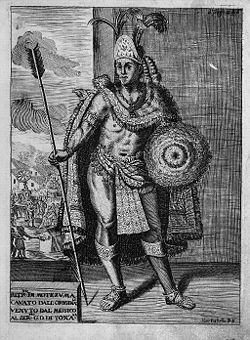
Montezuma's headdress
Encyclopedia

Featherwork
Featherwork is the working of feathers into a cultural artifact. This was especially elaborate among the peoples of Oceania and the Americas, such as the Incas and Aztecs....
crown
Crown (headgear)
A crown is the traditional symbolic form of headgear worn by a monarch or by a deity, for whom the crown traditionally represents power, legitimacy, immortality, righteousness, victory, triumph, resurrection, honour and glory of life after death. In art, the crown may be shown being offered to...
which tradition holds belonged to Moctezuma II
Moctezuma II
Moctezuma , also known by a number of variant spellings including Montezuma, Moteuczoma, Motecuhzoma and referred to in full by early Nahuatl texts as Motecuhzoma Xocoyotzin, was the ninth tlatoani or ruler of Tenochtitlan, reigning from 1502 to 1520...
, the Aztec emperor
Tlatoani
Tlatoani is the Nahuatl term for the ruler of an altepetl, a pre-Hispanic state. The word literally means "speaker", but may be translated into English as "king". A is a female ruler, or queen regnant....
at the time of the Spanish Conquest. However, its provenance is uncertain, and even its identity as a headdress has been questioned. It is made of quetzal
Quetzal
Quetzals are strikingly colored birds in the trogon family . They are found in forests and woodlands, especially in humid highlands, with the five species from the genus Pharomachrus being exclusively Neotropical, while the single Euptilotis species is almost entirely restricted to western Mexico...
and other feathers mounted in a base of gold studded with precious stones. It currently rests in the Museum of Ethnology, Vienna, and is a source of dispute between Austria
Austria
Austria , officially the Republic of Austria , is a landlocked country of roughly 8.4 million people in Central Europe. It is bordered by the Czech Republic and Germany to the north, Slovakia and Hungary to the east, Slovenia and Italy to the south, and Switzerland and Liechtenstein to the...
and Mexico
Mexico
The United Mexican States , commonly known as Mexico , is a federal constitutional republic in North America. It is bordered on the north by the United States; on the south and west by the Pacific Ocean; on the southeast by Guatemala, Belize, and the Caribbean Sea; and on the east by the Gulf of...
, as no similar pieces remain in Mexico.
Description
The feathers of the piece have deteriorated over the centuries. It is 116 cm (45.7 in) high and 175 cm (68.9 in) across and has the form of concentric layers of different colored feathers arranged in a semicircle. The smallest is made from blue feathers of the Cotinga amabilis (xiuhtōtōtl) with small plates of gold in the shapes of half moons, inlaid with precious stones. Behind this is a layer of pink flamingo (tlāuhquechōlli) feathers, then small quetzal feathers, then a layer of white-tipped red-brown feathers of the squirrel cuckoo, Piaya cayana, with three bands of small gold plates, and finally two of 400 closely spaced quetzal tail feathers, some 55 cm (21.7 in) long. The quetzal feathers in the center of the headdress are raised relative to the sides. Leather straps attach the crown to the head of the wearer.History
Although attributed to Montezuma and the Spanish conquest, the provenance of the piece is unattested, and it does not match Aztec illustrations of the headdress of their nobility. It became an object of interest to European researchers such as Ferdinand von HochstetterFerdinand von Hochstetter
Christian Gottlieb Ferdinand Ritter von Hochstetter was a German geologist.He was born at Esslingen, Württemberg, the son of Christian Ferdinand Friedrich Hochstetter , a clergyman and professor at Bonn, who was also a botanist and mineralogist...
and Eduard Seler
Eduard Seler
Eduard Georg Seler was a prominent German anthropologist, ethnohistorian, linguist, epigrapher, academic and Americanist scholar, who made extensive contributions in these fields towards the study of pre-Columbian era cultures in the Americas...
at the end of the 19th century, and its identification as a quetzalapanecayotl is attributed to US American anthropologist Zelia Nuttall
Zelia Nuttall
-References:-External links:* by Alfred M. Tozzer on American Ethnography....
. It was restored in 1878, while still thought to be a mantle
Mantle (clothing)
A mantle is a type of loose garment usually worn over indoor clothing to serve the same purpose as an overcoat...
rather than a headdress. It is attested since 1575 in the collections of Archduke Ferdinand in Ambras near Innsbruck
Innsbruck
- Main sights :- Buildings :*Golden Roof*Kaiserliche Hofburg *Hofkirche with the cenotaph of Maximilian I, Holy Roman Emperor*Altes Landhaus...
, Austria. At the beginning of the 19th century it was deposited in the Museum of Ethnology (inventory number 10402VO) in Vienna along with other liturgical artifacts of Quetzalcoatl
Ce Acatl Topiltzin
Cē Ācatl Topiltzin is a mythologised figure appearing in 16th-century accounts of Aztec and Nahua historical traditions, where he is identified as a ruler in the 10th century of the Toltecs—by Aztec tradition their predecessors who had political control of the Valley of Mexico and...
and Ehecatl
Ehecatl
Ehecatl is a pre-Columbian deity associated with the wind, who features in Aztec mythology and the mythologies of other cultures from the central Mexico region of Mesoamerica. He is most usually interpreted as the aspect of the Feathered Serpent deity as a god of wind, and is therefore also known...
.
External links
- Propuesta de trueque histórico por el Penacho
- "El penacho de Moctezuma es un atavío para la cabeza", nota de prensa emitida por el Conaculta
- "El penacho de Moctezuma es una capa de sacerdote, afirma un investigador", a letter in the journal La Jornada
- "Discutirá el Parlamento de Austria si devuelve el penacho de Moctezuma", in the journal La Jornada
- "Ve Austria difícil devolver penacho de Moctezuma", on Esmas.com
- "¿De quien es el penacho de Moctezuma?", by Carmen Cook de Leonard
- http://www.yankuikanahuak.o-f.com/Xoko.htm

